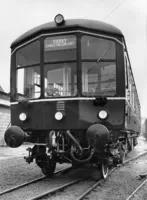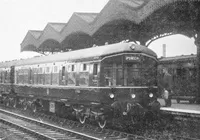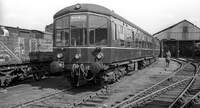Derby Lightweight (Yellow Diamond) 1, 2 & 4-car DMUs
East Anglia Operations
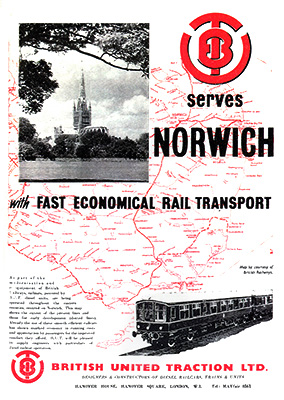
Derby Lightweight DMUs operated in East Anglia from 1955 to 1968. They would be allocated to Norwich (1955-1968) and Cambridge (1958-1968) depots — this page also covers their time allocated to Stratford depot (1956-1959).
Thirteen sets were built for the area, they would be joined by the thirteen sets built for Lincolnshire, and they would work with the Met-Camm "Lightweights" which had the same Yellow Diamond control system. All were two-car sets.
Their demise in the area was due to many lines closing, their non-standard control system, and an influx of Blue Square units from other areas.
Thirteen power trailer sets built for East Anglia
The sets were almost identical to the those built immediately before for Lincolnshire. The one difference was that the trailers were third class only. The trailer front saloon had three rows of 2+3 seating a fourth of 2+2 — the same arrangement as in the power car front saloon. This can be seen in the formation diagram below, and in this photo (note the seat height in the front saloon is the same as the centre saloon). It also meant they were given a slightly different number series away from the 796xx numbers used for composite vehicles.
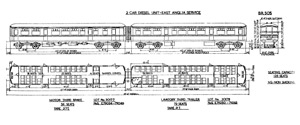
| Number | Type | Diagram | Lot. No | Seats | Weight |
|---|---|---|---|---|---|
| 79034 - 79046 | DMBT / DMBS | 504 | 30177 | 56 | 27t |
| 79250 - 79262 | DTTL / DTCL | 506? / 505 | 30178 | 72 then 16 / 53 | 21t |
Their livery when new was Loco Green with lion on wheel emblem on both vehicles and no whiskers.
The trailers were converted to composites when they were fairly new - around the time they received whiskers and lost the logo from their bodysides (although I have seen one picture of a conversion before whiskers). It's possible that as third class only they were diagram 506 — as composites they were diagram 505 and were now identical to the Lincolnshire vehicles.
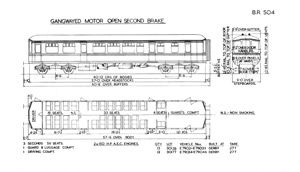

1955
Allocation changes
11/05/55
New to 32A:
79034 79250
28/05/55
New to 32A:
79036 79252
04/06/55
New to 32A:
79035 79251
Jun-55
New to 32A:
79037 79038 79253 79254
15/07/55
On loan to 40A:
79036
On loan to 37C:
79036
Jul-55
New to 32A:
79039 79040 79041 79042
79043 79255 79256 79257
79258 79259
On loan to 40A:
79040 79042 79043
Aug-55
New to 32A:
79044 79045 79046 79260
79261 79262
by 16/11/55
Ex-loan back to 32A:
79036 79040 79042 79043
The Eastern Region Assistant General Manager (AJ White) outlined the Region's modernisation plans in the March 1955 Eastern Region edition of the British Railways staff magazine. This included an initial allocation of fifty-five two-car sets (these would be 26 Derby Lightweights and 29 Met-Camm Lightweights) for the Lincoln, Norwich, Cambridge and Stratford districts. It was intended that all branch and secondary services would switch to diesel railcars within five or six years.
All thirteen sets were new to 32A (Norwich) between May and August.
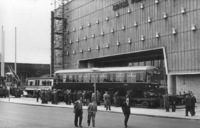
Before entering traffic E79035 was displayed at the Royal Festival Hall in London as part of an Aluminium Centenary Exhibition. It is shown being loaded into position on 16th May 1955. Also visible in the background is a London Underground vehicle. Lens of Sutton Collection/Chris Moxon Collection.

Under the wires between Shenfield and Brentwood this was likely a staff training run circa May 1955.
Limited Introduction
Despite an ASLEF strike, sets were introduced to services between Norwich and Yarmouth as planned on 30th May (Whit-Monday) 1955[1]. The allocations show that just two sets had been delivered by this date.
At Kings Lynn the diesel services started on the 9th June 1955 when E79036 + E79252 worked services between Kings Lynn and Dereham.[2]
During the strike, which lasted until June 14th, the DMUs managed to make three trips daily between Ipswich, Norwich and Yarmouth (Vauxhall), and on the 10th June a four-car formation (E79024 + 79616 / E79027 + 79619) was noted at Ipswich[3]. These were Lincolnshire vehicles - perhaps they had been borrowed until more Norwich sets were delivered?
Due to a vehicle shortage at Lincoln depot (40A) in July 1955 (three power cars were on loan to the West Riding area and one in shops after a collision), 79036/40/2/3 were loaned to Lincoln from Norwich. 79036 was subsequently loaned by Lincoln to Hammerton Street (37A). As their trailers (79252/6/8/9) did not have 1st class accommodation they were stored at Bardney. During July 1955 79034/5/7/8/9/41 with 79250/1/3/4/5/7 respectively were noted in the Norwich area. In the first week of the month, sets 79035/251 and 79037/253 were noted in the Kings Lynn area running trials empty to both Dereham and Hunstanton.[4]
Circa July/August the DMUs were requested for an excursion from Harling Road to Yarmouth (Vauxhall) and the three sets were well loaded[5]. In August 1955 three sets formed a Sunday Harling Road - Norwich excursion[6].
E79044/79260 were noted in Derby C&W works on 13th August 1955 awaiting delivery.[7]
Winter Timetable
With all thirteen sets now delivered more DMUs were introduced to services with the winter timetable on Monday 19th September 1955. These covered the majority of services between King's Lynn and Dereham; Wells, Dereham and Norwich Thorpe; Norwich Thorpe and Ipswich; Norwich Thorpe and Yarmouth Vauxhall; and Norwich, Cromer, Sheringham and Holt.[8]
This meant that DMUs now worked over most of East Anglia north of Norwich, and all of the services — except those over the former Midland & Great Northern Joint Line and workings from outside the area — would be diesel worked. It was the second reasonably self-contained area into which these railcars had been introduced (the other being West Cumberland).[9].
Services were increased and journey times shortened. Units were stabled at Norwich, Dereham and Kings Lynn. On Sundays the Kings Lynn unit worked between Ely and Hunstanton and the Norwich unit to Cromer, Sheringham and Holt.[10]
Norwich Depot
In 1955 work began on building a new diesel depot at Norwich to handle the railcars and diesel shunters on a site adjacent to the steam motive power depot so the same office and mess facilities could be used. The depot had three roads all equipped with pits to work underneath vehicles, two of the roads had short platforms for working on the shunters. The depot was supplied with equipment for the removal and fitting of engines and transmissions, there was a small workshop to provide a clean area for the examination and testing of fuel injectors and other special work, a store for consumables and spares, and battery charging equipment.
The track layout arrangement at Norwich Thorpe Station meant that vehicles would only go to the depot if they required attention, the carriage sidings in the station would be used for stabling, cleaning and basic exams, and fuelling would be done there with a new gravity type installation.[11]
1956
09/09/56
Transferred to 30A:
79034 79035 79250 79251
16/09/56
Transferred to 30A:
79036 79252
4w/e 13/10/56
Transferred to 32A:
79021 79022 79023 79613
79614 79615
Transferred to 30A:
79037 79039 79253 79255
The Norwich DMU fleet was increased with the arrival of ten Met-Camm "Lightweight" (MCL) sets delivered new in January and February. As they had the same Yellow Diamond coupling codes the two types could work together. Unfortunately, mentions in the railway press weren't always specific as to the type of DMU it was referring to so for some of the mentions on this page it it unclear whether they refer to the Derby Lightweights or the MCLs, but in most cases the two types worked side by side and even hybrid sets would occassionaly be noted. Some of the notes on the remainder of the page — particularly one off workings — may not be Derby Lightweights...
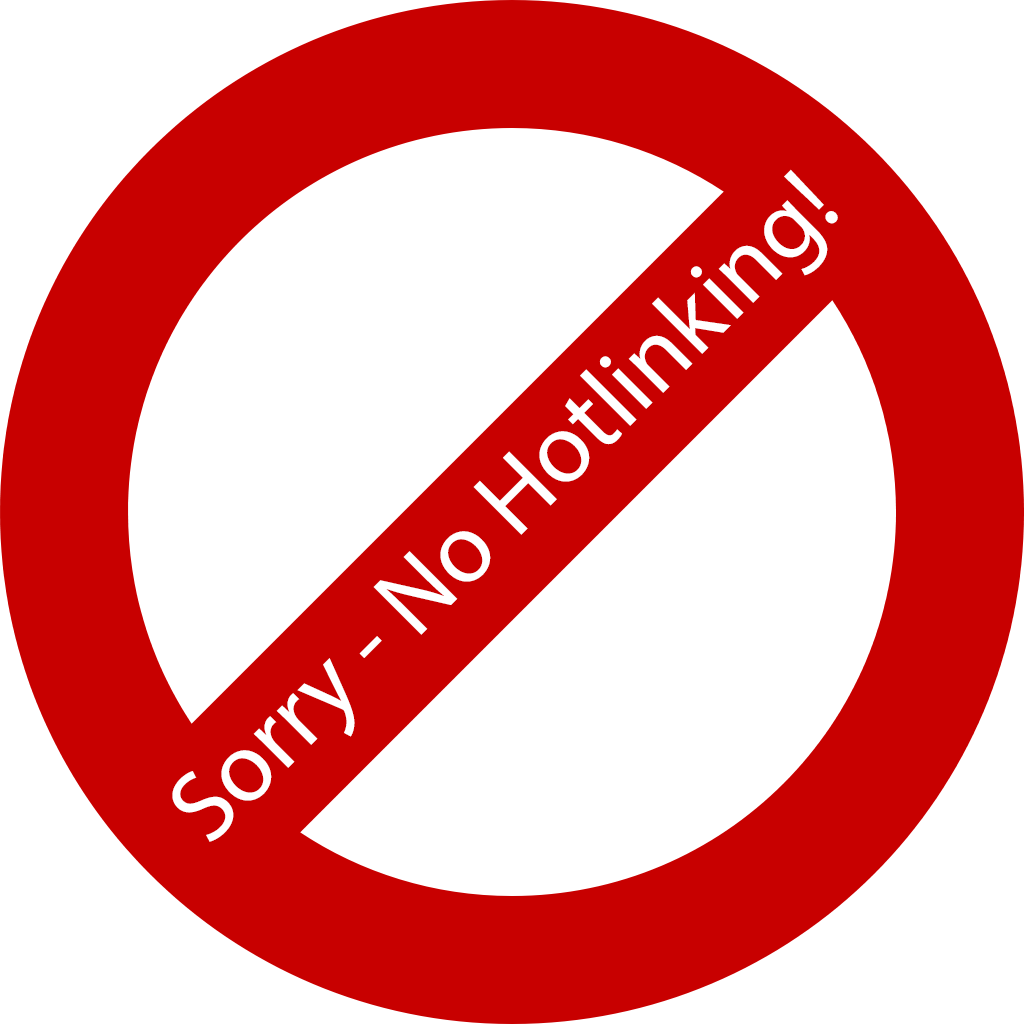
Mundesely
This Eastern Region publicity image shows a Derby Lightweight set on 14 May 1956. The supplied caption reads: "A two car diesel train in an attractive country setting approaching Whitlingham on the Norwich-Mundesely service. Diesel car trains came into operation on the Norwich-North Walsham-Mundeseley services on Monday 9th April." British Railways.
E79048 + E79264 worked the 4.17pm Dereham - Kings Lynn on 10 May. Only a few passengers got off at Kings Lynn but after the five minute turn round is was comfortably filled for the 5.15pm return working.[12]
Private Charter
On the 12th May 1956 the father of an RCTS member organised a charter from Ipswich to visit Doncaster Works. This was worked by E79043 + E79259 which ran via Bury St. Edmunds, Ely, Sleaford and Lincoln. Refreshments were served en-route. On the return journey there were signs of possible overheating so passengers changed to a Met-Camm Lightweight (Lincoln allocated E79062 + E79278) at Lincoln[13]. Another source noted the reason of the failure being that E79043 + E79259, supplied from Norwich, had been a last-minute substition for another which had failed, it had been sent out with insufficient fuel[14].
Summer Timetable
Diesel railcars would now work services from Ipswich on routes to Witham, Colchester, Norwich and Aldeburgh.[15]. The replacement of steam on the Aldeburgh Branch allowed a considerably augmented service with two trains in each direction running through to Ipswich. [16]
They also started on the Swaffham - Thetford branch, although normally worked by a Met-Camm lightweight based at Dereham. They also started on certain trains over the Yarmouth Vauxhall line at this time.
Third to Second
On June 3rd 1956 third class became second class. No alterations to the vehicles was needed, it was simply a name change, although vehicle designations painted on the ends would eventually be updated, BTO to BSO and TO to SO.
Norwich Allocations
In August 1956 Norwich was allocated thirteen DL sets, 79034/79250 to 79046/79262 and eleven Met-Camm Lightweight sets. Although all allocated to Norwich Thorpe (32A) and maintained and serviced in the new diesel shop which was nearing completion, they were regularly outstationed at East Dereham, Kings Lynn and Ipswich for working the branches in these areas. They were used in multiple with Met-Camm Lightweights when required in 4 or 6-car sets. [17]
Movements
Probably tied with the winter timetable beginning on the 17th September there was some movement of sets, with five of the 'East Anglia' Derby Lightweights (which were second class only) moving from Norwich to Stratford (30A), but Norwich would get three of the 'Lincolnshire' Derby Lightweights (which had first class). The depot would also gain more MCL sets from Stratford and Lincoln, meaning it would now have eleven DLs and eighteen MCLs.
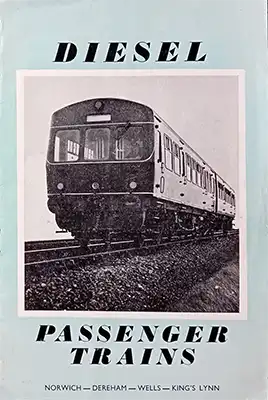
1956 Winter Timetable
From the 17th September 1956 sets were introduced on all local services between Norwich Thorpe, Lowestoft Central, and Yarmouth Vauxhall with accelerated timings and an even-interval service. [18]
On the same date DMUs were also introduced between Ipswich and Colchester and Manningtree[19], Norwich and Ely.[18], and on the Harwich branch.[20]
Many of the East Anglian branch lines services were worked by Norwich based sets. Significant numbers were allocated to Cambridge and Norwich Thorpe. They were one of the last vehicle types to use the old M&GN system before closure in 1959.
Training
To teach steam drivers about the new diesel traction the Eastern Region opened a training school at St. Ronans, Hadley Wood in late 1956. By the end of the year drivers from Lincoln, Boston, Grantham, Stratford, Kings Lynn and Norwich had attended the two week courses[21]. More details on staff training on the Eastern Region.
Stratford
This depot received its first Derby Lightweights in September 1956 for use on the Wickford to Southminster (which had been running with MCLs since June) and Romford to Upminster lines, to which DMUs were introduced in the winter timetable on September 17th.
The railcars allowed the Romford to Upminster trains to change from an irregular rush hour and Saturday afternoon service to an approximately half-hourly interval service, connecting at either end with electric services (Liverpool St. - Shenfield and the underground District Line), but there were still no Sunday trains.
Between Wickford and Southminster they ran to existing timings, with some Sunday alterations, until the Liverpool St to Southend Victoria electrification came into effect on the 31st December 1956 when services were re-timed and connections improved[20]. The unit noted in service on the first day was E79035 + E79251 and it had no destination blind for the line. It was also commented on as having dents, scratches and a thick coat of grime! [22]
On the 4th October 1956 79036/252 failed in Romford station when about to work the 6.05pm to Upminster but was replaced by 79037/253 which was quickly dispatched from Stratford and arrived in Romford in time to do the necessary shunting operation to get in to No. 1 platform and depart on the next working (6.35pm) only one minute late. [23]
Moderate Success
A Government White Paper released in October 1956 noted that takings on the Kings Lynn-Wells-Norwich diesel services had increased by 30% compared with the same period of steam operation, a very low figure compared with the increases on the Birmingham-Lichfield (208%) and Bury-Bacup (164%) services.[24]
1957
10/02/57
Transferred to 40A:
79034 79250
26/05/57
Transferred to 39A:
79034 79250
15/09/57
Transferred to 32A:
79025 79028 79033 79034
79250 79617 79620 79625
Transferred to 30A:
79029 79621
4w/e 02/11/57
Transferred to 32A:
79024 79616
Nov-57
Transferred to 32A:
79026 79618
4w/e 28/12/57
Transferred to 32A:
79027 79032 79619 79624
A diesel unit was booked to work on the M&GN section from Norwich Thorpe to Norwich City via Cromer and Melton Constable and return on 18 March, and at this time the Norwich City branch was expected to be worked by diesels from the 1957 winter timetable. [25]
Two two-car sets were charted to take a party of Ipswich schoolchildren on a tour of East Anglia on 8 May. It departed from Derby Road at 9am and headed through Colchester, Marks Tey and the Colne Valley line for a stop at Cambridge from 11.52am to 2.21pm. It then proceeded to Ely (arr. 2.40 dep. 5.00pm) before the return journey via Soham and Bury St Edmunds, getting back to London Road at 6.45pm. [26]

In the image A Derby Lightweight sits in the bay platform at Wickford Junction, circa early 1957 with a Southminster service. DTC E79252 is closest, presumably with DMBS E79036. They had been delivered to Norwich and transferred to Stratford in September 1956. On the left an EMU enters with a Down train, the Shenfield to Southend had just recently been electrified. British Railways.
In the summer diesel excursions from the LT&S Section were popular, running almost every weekend from 16 June. This would normally involve a two-car set from Southend and another from Tilbury joining at Barking. On one occasion, when the tour was running to East Anglia, the Southend set ran from the GE station and joined the Tilbury set at Shenfield. [27]
A DMU was used to propel a nine-car Shenfield EMU into Wickford station after it had been wrongly routed onto the non-electrified Southminster branch on the morning of 22 July. [28]
Five Wickham units were delivered to Stratford from August 1957 onwards. Despite being Blue Square units they began to appear on the Stratford diagrams alongside the Lightweights.
Winter Services
Diesels were introduced to the Yarmouth-Gorleston-Lowestoft service and the existing diesel services between Norwich, Cromer, Sheringham, Melton Constable and Norwich City were extended[29]. Two extra train were added on the Norwich City - Melton Constable line in both directions, while some through services such as Melton Constable - Liverpool Street were discontinued. The Melton Constable - Cromer service was completely reorganised. [30]
Liverpool Street
On Saturday 21 December a two-car set arrived into Liverpool Street shortly after 9am with a special from Lowestoft. [31]
Norwich Sets
In late 1957 Norwich depot had 38 twin units comprised of Derby and Met-Camm Lightweights. The sets worked all of the ER East Anglia services with the exception of the Romford - Upminster service, reaching as far south as Chelmsford and the Brightlingsea branch and to Kings Lynn in the West. There were 30 diagrams for the sets, 24 actually working trains and the other six strengthening peak services. These diagrams were based on a day's working, but they were grouped in eight cycles to fit in with the maintenance schedule for each set. As well as the daily routine examination, the motive power and C&W departments did a more extensive service after 1,250 - 1,500 miles. As most of the diagrams covered between 300 - 400 miles daily, most of the diagrams were grouped into a four-day cycle that brought each unit back to Norwich for attention on the fifth day. On other nights of the cycle units could be stabled at on of the sub-depots such as Dereham, Ipswich or Yarmouth.
Six sets were normally stabled at Ipswich for workings to Norwich. [28]
Sets were not always out of service for maintenance on the fifth day, as if no major maintenance was required, the work could be completed by the night shift at Norwich so the unit was ready for action again the first thing the next morning. In July 1957 one set worked 30 days of the 31 running up nearly 10,000 miles in the period. At 3,000 miles there was a more thorough inspection of the whole railcar, including its grease and oil points; at 6,000 miles, amongst other tasks, the filters on all systems were renewed, engine oil changed and tappet clearances checked. At 12,000 miles the work included testing of the injection equipment and examination of the final drives. Between 30,000 and 36,000 miles there was a major overhaul involving a thorough examination of the engine, regrinding of the valves, inspection of the transmission and drive and removal of the electrical equipment for checking. Engines were changed for major overhaul between 100,000 and 120,000 miles.
1958
4w/e 25/01/58
Transferred to 32A:
79031 79623
w/e 01/02/58
Transferred to 32A:
79030 79622
04/06/58
Transferred to 31A:
79035 79036 79251 79252
29/06/58
Transferred to 32A:
79035 79036 79251 79252
4w/e 04/10/58
Transferred to 31A:
79021 79022 79023 79024
79025 79613 79614 79615
79616 79617
Transferred to 32A:
79039 79255
4w/e 01/11/58
Transferred to 30A:
79021 79022 79024 79613
79614 79617
02/11/58
Transferred to 30A:
79023 79025 79615 79616

A Derby Lightweight and locomotives assembled in Stratford depot ready for a visit of the Minister of Transport on 7 January 1958.
On 6 January 1958 a new Upminster - Grays - Tilbury diesel service was introduced. It was basically a half-hourly regular interval service with trains crossing at Ockendon. During the rush hour the service was irregular with some trains running through to Tilbury formed of two 2-car sets. on Saturday 18 January the services were worked by E79035 + E79251, E79036 + E79252 and two MCLs. [32]
On Sundays in March 1958 the service between Liverpool Street and Enfield Town was withdrawn to allow for pre-electrification work. A shuttle operated between Enfield Town and Lower Edmonton (HL). E79037 + E79253 worked the half hourly service on the 16th (it was Wickham twins on the 2nd/9th). [33]
On 22 March E79043 + E79259 were noted in the diesel shed at Stratford. [34]

Hybrid Derby / Met-Camm Lightweights were unusual but not unknown. Here one forms a Lowestoft service at Oulton Broad North. Date unknown. Rail Online. Opens in external site.
Cambridge
It has been the intention to transfer eight Norwich sets to Cambridge to work six existing GE diagrams from February. A shortage of railcars meant this was postponed till 10 March, then postponed again possibly to the start of the summer timetable.[35], and two Derby Lightweight sets were transferred there at the start of June, they only lasted a few weeks before being returned to Norwich. Cravens twins began to be delivered from July.
There were changes with the summer timetable to some services on the Ely - Mildenhall - Newmarket lines. One involved a DMU thay had previously sat idle at Ely for two hours which now worked a 10.25am SX Ely - Newmarket via Mildenhall or 10.45 SO Ely - Newmarket, returning to Ely ECS. [36]
A schools excursion on 2 July was operated by E79025 + E79250 from Ipswich Derby Road to Chessington South. It departed following the up “Broadsman” from Ipswich making a non-stop run was made to Channelsea Jct, where there was a crew change. It then ran via Victoria Park, Camden Road, Hampstead Heath, Willesden Jct (H.C.), Kensington Olympia, Clapham Jct, East Putney, and Wimbledon, arriving at Chessington South at 12.01pm. The return departed at 6.08pm and travelled the same route, arriving at Ipswich at 9.14pm and Derby Road on time at 9.42pm after a scheduled wait for crossing purposes. [36]

The image shows passengers on a school run on the Mundesley branch circa 1958. Tim Stubbs.
Five sets moved to Norwich to Cambridge in September, after a few weeks they moved on to Stratford.
All five sets Wickham sets were re-allocated from Stratford to Cambridge depot (31A) in late 1958 / early 1959, a swap for Derby Lightweight sets 79021-5/79613-7 which had only been transferred from Norwich to Cambridge a few weeks earlier.
1959
3w/e 06/06/59
Transferred to 32A:
79037 79253
4w/e 13/06/59
Transferred to 31A:
79021 79022 79023 79024
79025 79026 79027 79028
79029 79031 79032 79033
79613 79614 79615 79616
79617 79618 79619 79620
79621 79623 79624
31/05/59
Transferred to 31A:
79625
3w/e 04/07/59
Transferred to 31A:
79034 79035 79036 79250
79251 79252
4w/e 11/07/59
Transferred to 31A:
79030 79622
01/11/59
Transferred to 32A:
79036 79252
4w/e 28/11/59
Transferred to 32A:
79032 79033 79034 79035
79250 79251 79624 79625
At the start of 1959 Norwich had 38 twin sets - 15 Derby Lightweights and 23 Met-Camm Lightweights; Cambridge had 30 Blue Square twins (Cravens and Wickham) and five German railbuses; Stratford had 7 Derby Lightweights, 8 Met-Camm Lightweights, one Wickham just about to be move to Cambridge, and newly delivered was the first Rolls-Royce powered Derby suburban triple (Class 125).

The image shows a set heading to Cambridge at Birdbrook on the Colne Valley & Halstead line - date unknown. John Vaughan / Steve Davies Collection.
From 5 January the whole of the Colchester line services — including on the East Suffolk and other branches — where drastically revised. With a couple of couple of exceptions all Cromer trains now terminated at Norwich, Yarmouth and Lowestoft now had three trains per day although diesel services would provide connecting services onto Norwich - Liverpool Street services. [37]
From 2 March an increased service was implemented between Melton Constable, Cromer Beach and Norwich. There was an opinion that the service was now heavier than the traffic warranted and was an attempt to increase costs as a prelude to closure[38]. The services to Melton Constable showed Holt on the destination blind, raising the question as to whether the blinds included Melton. [39]
With continued deliveries of the Derby triples to Stratford the seven Derby Lightweight sets there moved on, the six former Lincolnshire sets to Cambridge and the original EA one to Norwich. No more Derby Lightweights would be allocated to Stratford.
Four Norwich sets were transferred to Cambridge in the middle of the year, the same four moved back in November.
Railcars took over the Long Melford - Bury St Edmunds branch on 2 November. [40]

In the image DMBS E79030 is closest (carrying the the tail lamp). Date unknown, taken at Melton Constable on the Midland & Great Northern Joint line, the lifted line to North Walsham on the left. John Vaughan / Steve Davies Collection.
1960
Feb-60
Transferred to 31A:
79032 79624
4w/e 20/02/60
Transferred to 31A:
79262
Transferred to 32A:
79621
Feb-60
Transferred to 31A:
79037 79256
Jul-60
Transferred to 31A:
79046
Transferred to 32A:
79037 79046 79256
5w/e 06/08/60
Transferred to 32A:
79029 79613
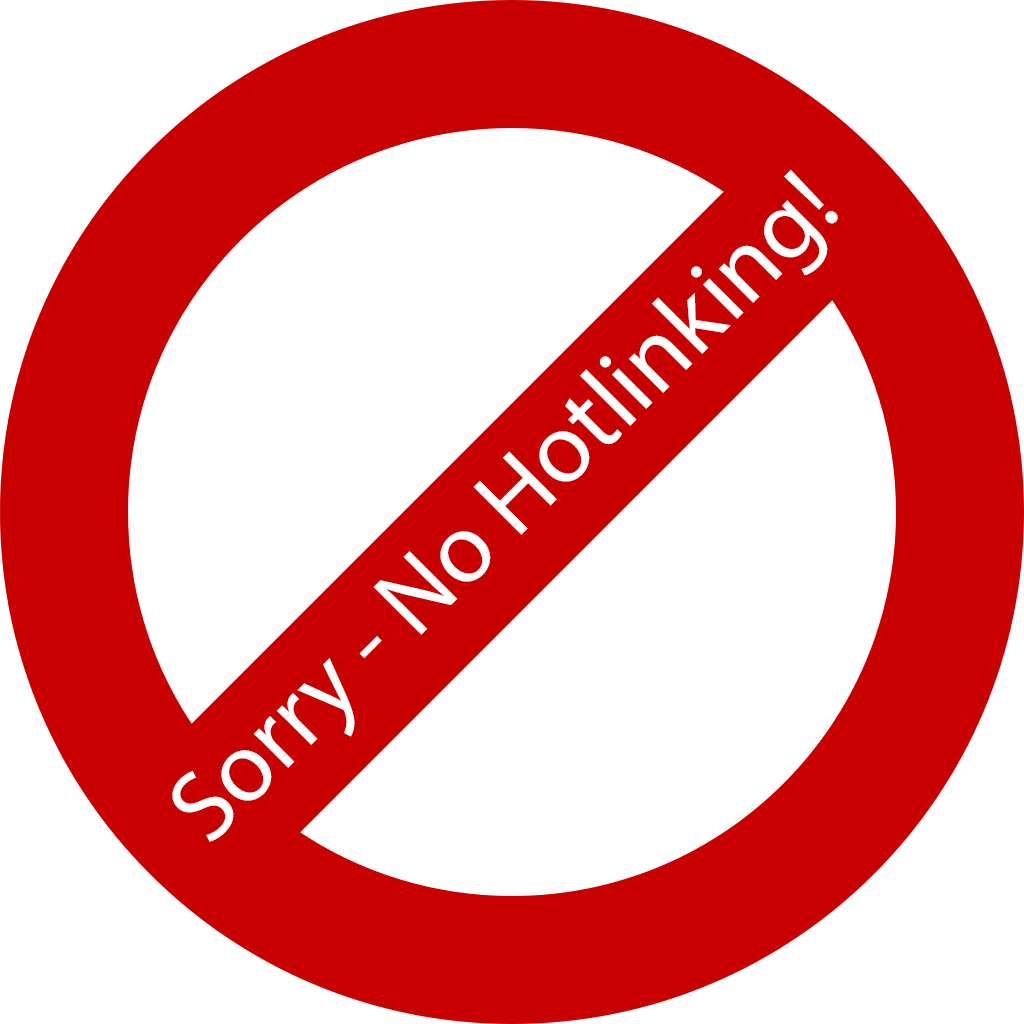
The first image shows DTCL E79613 at March 5th March 1960. Keith Long.

The second image shows the 12.32pm Peterborough North - Cambridge at Peterborough East on Whit Monday, June 6, 1960, led by E79624. Michael Mensing.
Diesel-hauled stock replaced DMUs working between Ipswich and Yarmouth from 18 July, the railcars were then used to lengthen trains in the Norwich district.[41]
From the summer sets began to returning to Norfolk from works repainted into the darker Loco Green with a light green rubber panel adjacent to the driver's cab door window to prevent single line tablets from damaging the paintwork. They are also being equipped with telephone communication between the driver and guard, and the engines were governed to 65mph.[42]
The East Anglian units feature in film clips on the East Anglian Film Archive, including:
Train Journey From Saxmundham To Aldeburgh (1960)
DMU at North Walsham station (1961)
John Betjeman Goes By Train (1962)
1961
29/07/61
Withdrawn from 32A:
79042
4w/e 02/12/61
Transferred to 31A:
79041 79257

The image shows a set at Briningham (just north of Melton Constable), with Norwich on the destination blind. Undated, the line closed in 1964. John Vaughan / Steve Davies Collection.
DMBS E79042 suffered fire damage, details of the incident are unknown but it was withdrawn from Norwich on 29 July[43] — the first yellow diamond vehicle to be withdrawn. It would be noted at Stratford with all its underframe equipment removed. On the number one side there was fire damage rising up from the second axle (the one with the final drive) on the leading bogie, and above where the engine / gearbox were. The damage was greater above the engine with some frame distortion evident. Sheringham was on the destination blind, which could have been its last working.
1962
4w/e 28/04/62
Transferred to 31A:
79258
02/06/62
Withdrawn from 31A:
79616
2w/e 23/06/62
Transferred to 32A:
79030 79031 79032 79041
79257 79622 79623 79624
At the start of 1962 Norwich had 35 twin sets (13 DLs and 22 MCLs) and an odd DL trailer (79258, after the withdrawal of 79042). Cambridge had 12 DL twins, no MCLs, 3 Wickham and 15 Cravens twins and the 5 German railbuses.
Cambridge trailer E79616 suffered collision damage in early 1962[44] and would be withdrawn. The odd trailer (E79258) at Norwich moved to Cambridge to take its place.

The first picture is a British Railways publicity image showing two 2-car Derby Lightweight sets in Norwich Thorpe station in 1962. Displaying Sheringham on the destination blind, E79045 is paired with E79261 as the first set. British Railways.
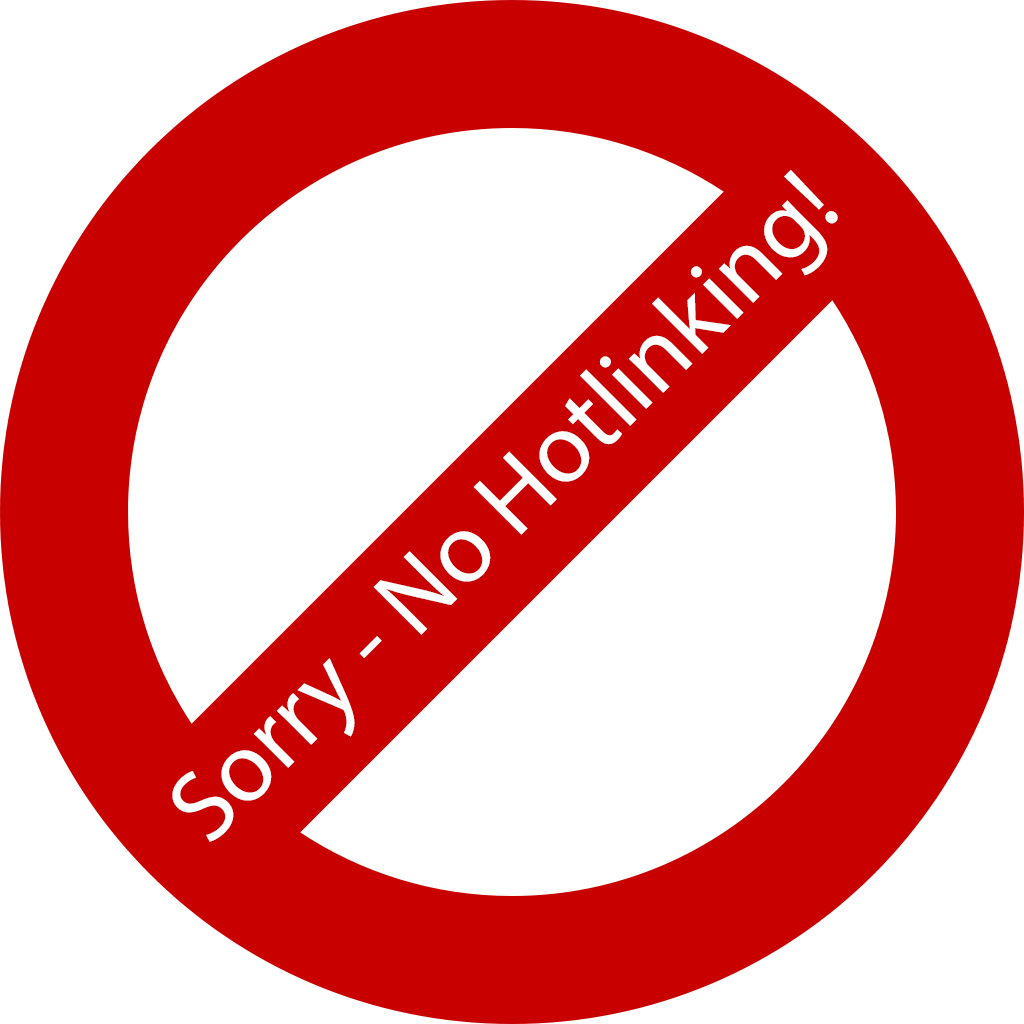
The second images shows a set in Lieston station (Suffolk) in 1962. The closest vehicle appears to be E79259. Ian Dinmore/railarchive.org.uk.
1963
3w/e 02/02/63
Transferred to 32A:
79028 79620
Dec-63
Transferred to 31A:
79028 79620

E79023 is the DMBS in this Derby Lightweight set seen at Long Melford, date unknown. John Vaughan / Steve Davies Collection.

A set in Sudbury station, date unknown. John Vaughan / Steve Davies Collection.

DMBS E79037 on the rear of a Derby Lightweight two-car DMU heading for Norwich, date and location unknown, but possibly at Fakenham (East) station. John Vaughan / Steve Davies Collection.
1964
Oct-64
Transferred to 31A:
79030 79032 79622 79624
Nov-64
Transferred to 31A:
79029 79031 79621 79623

The first image shows a view from a Derby Lightweight between Norwich and North Walsham in a snowy January 1964.

The second image shows a Derby Lightweight twin at Norwich Fuel Point in the mid-1960s. Both Tim Stubbs.
1965
06/06/65
Withdrawn from 32A:
79041
w/e 19/06/65
Transferred to 31A:
79137 79138 79140 79658
79660 79661
circa June 1965
Transferred to 31A:
79613
A very useful survey of all DMUs by D.W. Allen appeared in 1965 issues of The Railway Observer. The allocations and normal workings of the East Anglian Derby Lightweights at the start of the year were recorded as:[45]
Cambridge: 79021-32 and 79251/8/62, E79614/5/7/9-24 for local services from Cambridge Manningtree - Dovercourt (also 3 Wickhams, 5 German railbuses and 10 Cravens which the latter were also noted as Manningtree - Dovercourt amongst other workings)
Norwich: E79033-41/3-6 with E79613/8/25, E79250/2-7/9-61 along with MCLS E79047-68 with E79263-84 for working all Norfolk and East Suffolk branches including Ipswich-Felixstowe.
Bletchley / Oxford services
In January Bletchley depot received a batch of Derby Lightweights from other LMR depots to replace the Blue Square Derby Lightweights (Class 108s) on the Oxford - Cambridge and Bletchley - Cambridge services, services being datated for closure.
By June the East Anglian allocated sets were also noted as appearing on this line, normally on an evening service, either the 18:01 or 19:00 ex-Cambridge[46]
In June the three twin sets that South Gosforth had moved to Cambridge: 79137/8/40 with 79658/60/1.
At the end of the year the once reliable Oxford, Bedford and Cambridge passenger services were noted as having been allowed to run down. Timekeeping was poor as was the condition of the DMUs which were in constant need of attention. There was an inability to refuel the busy 07:14 Bletchley-Cambridge which had been noted up to 40 minutes late and the 07:28 Cambridge-Bletchley was very unreliable with consequences on connections. In the run up to Christmas lengthy parcel trains used the line and the loading/unloading times caused further delay to passenger service particularly at St Johns.[47]
1966
16/10/66
On loan to 64H:
79033 79034 79035 79036
79250 79251 79252 79625
06/11/66
Transferred to 64H:
79033 79034 79035 79036
79250 79251 79252 79625
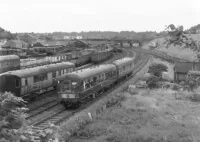
The image shows a twin set passing East Suffolk Junction on 2 June 1966. John Vaughan / Steve Davies Collection.
Forty-three stations on the Kings Lynn - Norwich service via Wymondham and Dereham became unstaffed halts from 15 August, the DMU guard now being responsable for issuing tickets. The Kings Lynn - Dereham section had already been scheduled for closure.[48]
On 10 September passenger services were withdrawn from the Saxmundham and Aldeburgh branch, and from 5 November local services were withdrawn between Ipswich and Cambridge.[48]
These reductions in Norwich workings allowed four Norwich sets 79033-6 and 79250-2/625 to go to Scotland on loan to Leith Central depot in October, along with others from Bletchley and South Gosforth. The transfer became permament in November, they would be withdrawn in June 1967.
Notes from a journey on board the 15:00 Colchester - Cambridge service over the Stour Valley Line on 7 December showed it was formed of a two-car DMU allocated to Cambridge.[49]
1967
w/e 07/01/67
Transferred to 31A:
79037 79038 79039 79253
79254 79255
12/06/67
Withdrawn from 64H:
79033 79034 79035 79036
79250 79251 79252 79625
Jul-67
Withdrawn from 31A:
79661
4w/e 05/08/67
Withdrawn from 32A:
79040 79256
Withdrawn from 31A:
79620
5w/e 12/08/67
Transferred to 32A:
79132 79133 79656 79665
10/09/67
Withdrawn from 31A:
79028 79032 79262
Withdrawn from 32A:
79043 79045 79259 79261
Oct-67
Reinstated 31A:
79029
P10/67
Withdrawn from 32A:
79132 79133 79656 79665
15/10/67
Withdrawn from 31A:
79039
4w/e 04/11/67
Reinstated 31A:
79028
19/11/67
Withdrawn from 31A:
79258
26/11/67
Withdrawn from 31A:
79029
The year starts with 8 sets at Norwich depot (all from the original East Anglian batch), the depot also having 22 Met-Camm Lightweight twins. Cambridge has 15 Derby Lightweights (12 built for Lincolnshire and 3 ex-NER) and a spare trailer, no Met-Camm Lightweights but 14 Cravens and Wickham twins.
The allocations changed in the first week of January with three Norwich sets moving to Cambridge.
Line closures continued with the Stour Valley Line between Sudbury and Cambridge closing in March.
In an odd move two Bletchley sets (79132/3 with 79656/65) were transferred to Norwich depot circa July. They were withdrawn in the autumn.
Cambridge allocated vehicles E79023 + E79658 worked the North Norfolk Railway's "The Fenlands Rambler" railtour on 7 October 1967. Running from Cambridge though Peterborough, Bury St Edmonds, Ipswich, Lowestoft and Norwich it reached Sheringham where buses took passengers to Weybourne for the North North Norfolk Railway. The return journey was more direct via Norwich and Thetford[50]. This image shows the tour at Ely.
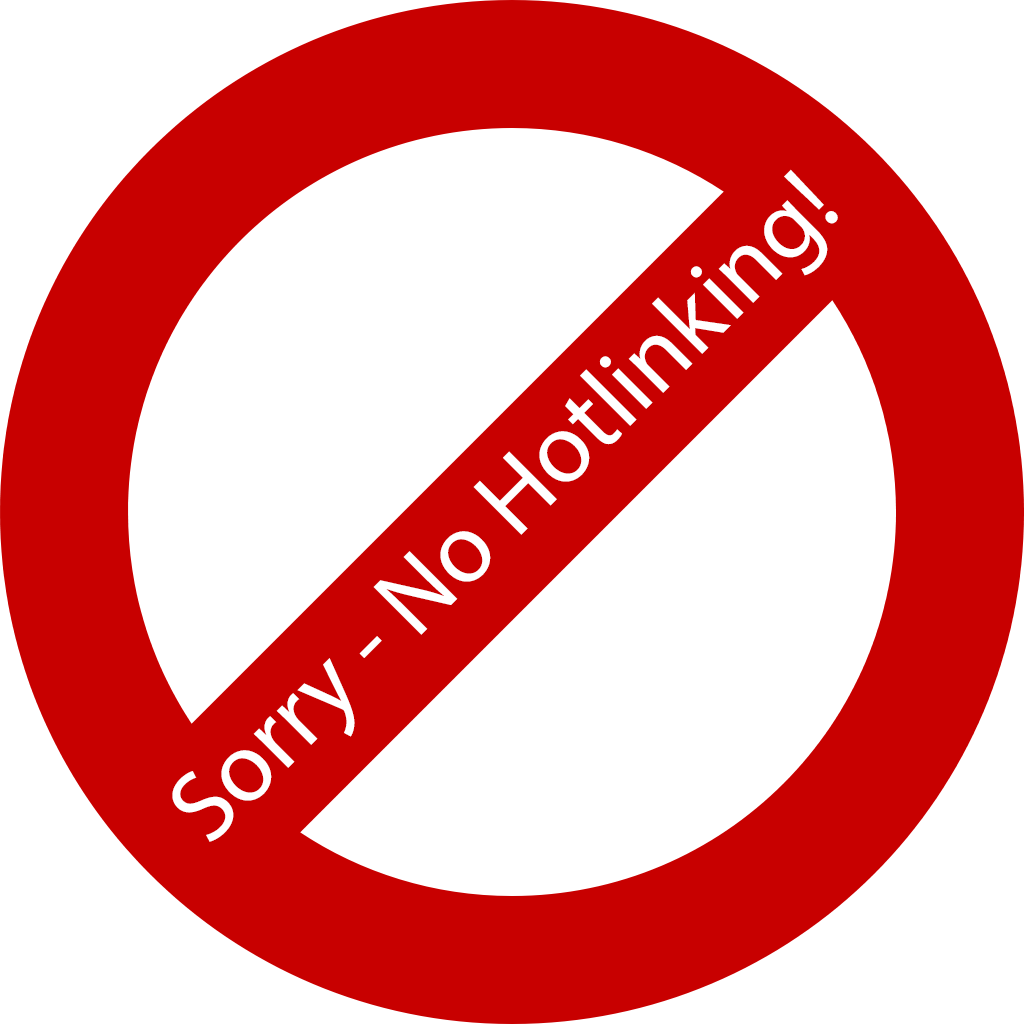
DTCL E79261 in the sidings at Cambridge on 7 November 1967. It had been withdrawn a few weeks earlier after spending all of its short twelve year career allocated to Norwich depot. Stuart Mackay Collection.
The last through Oxford - Cambridge service ran on Saturday 30 December.
1968 - the final year
19/05/68
Withdrawn from 31A:
79021 79022 79025 79037
79038 79613 79622 79624
79658 79660
16/06/68
Withdrawn from 31A:
79023 79024 79026 79027
79028 79030 79031 79137
79138 79140 79253 79254
79255 79614 79615 79617
79618 79619 79621 79623
Withdrawn from 32A:
79046 79257
08/09/68
Withdrawn from 32A:
79044 79260
At the start of the year Norwich had just two Derby Lightweight twins. One, E79044 + E79260, was an original pairing that had been at the depot since it was new*. The other set was E79046 + E79257, a non-original pairing of which both vehicles had spent time at Cambridge. It also had 22 Met-Camm twins.
*The only other Eastern Region Derby Lightweight vehicles that were never reallocated were E79045, E79259 and E79261.
Cambridge had 15 Derby Lightweight twins formed from power cars 79021-8/30/1/7/8 from the original ER batch and 79137/8/40 ex-South Gosforth and trailers 79253-5, 79613-5/7-9/21-4 (originals) and 79658-60 from South Gosforth. It also had 12 Blue Square twins.
Cambridge withdrawals
Cambridge would receive a Class 108 twin from Scotland in January, followed by nine Class 100 and two Class 101 twins also from the ScR in May. This allowed 9 DL vehicles to be withdrawn from the depot on May 19. The two ex-ScR 101s moved to Norwich in June but a further five 101 twins arrived mainly from Neville Hill and a couple of Cravens from Hull would be allocated to Cambridge that month allowing the last Derby Lightweights to be withdrawn from the depot on June 16.
Cambridge was now a Blue Square only depot.

Norwich Withdrawals
The image shows a set on a down service arriving at Subdury on the 1st June 1968. David Underwood. Would this working be a Cambridge or a Norwich diagram after the closure of the Cambridge - Sudbury section?
Norwich depot received its first Blue Square vehicles in June, the two ex-ScR Met-Camm twins from Cambridge, and this likely allowed the withdrawal of the first of the two Norwich Derby Lightweight sets on June 16.
In August, another two Met-Camm twins arrived from Neville Hill, in September four more of these arrived from Cambridge allowing the final Derby Lightweight set in East Anglia to be withdrawn on September 8.
Norwich wasn't completely rid of Yellow Diamond sets though, the depot still had a fleet of Met-Camm Lightweights. They would be gradually replaced some with surviving until June 1969.
After Withdrawal
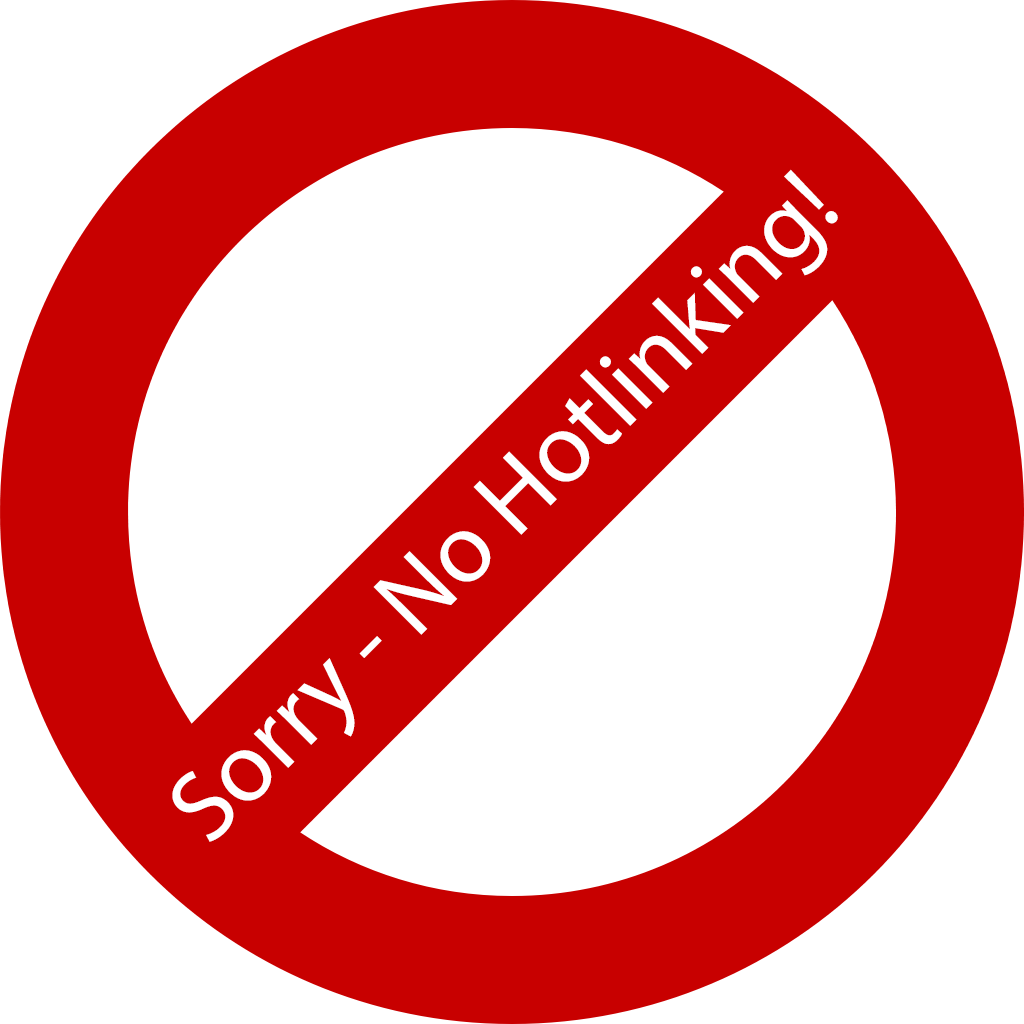
Original Norwich vehicle 79036 had moved to the Scottish Region in late 1966. After withdrawal in June 1967 in found some further use a route learner, thought to be based at York. The image shows it with 79189 at West Parade North Junction on the Scarborough line at Hull in May 1968. Leonard Rogers.
Two of the Norwich trailers that moved to ScR and were withdrawn on the same dates also found further use, 79250/2 became 975013/4 as staff mess coaches at various Scottish locations.
A visit to Cambridge Coldhams Lane depot on 29 August 1968 found the following withdrawn vehicles awaiting disposal:[51]
79021*/2/3/4*/5/6*/7*/8*/9-32/7/8/9/43/5
79137/8/40*
79253/4/5*/8/61/2
79613*/4/5/7/8*/9*/21/2/3/4*/58/60
* in blue livery
Many withdrawn Norwich vehicles would move to Ipswich before scrapping. Noted there circa January 1969 were 79044, 79046 (the only blue one of the three) and 79260 with many Met-Camm Lightweights[51]. It seems no component recovery was done as 79044 was later pictured in Cohen's scrapyard with all underframe equipment intact.

The image shows E79133 at the front of a line of withdrawn yellow diamond Derby and Met-Camm Lightweight vehicles at Ipswich loco depot circa early 1970. The next vehicle in the line is 79656. Tony Wilkins.
The Virgin Soldiers movie
E79253, withdrawn from Cambridge on 16 June 1968, had a connection with this feature film. A scene where a train is ambushed and wrecked was filmed later that year on the former Saffron Walden branch at Bartlow.
The Disused Station website features an in-depth article on the filming by Darren Kitson. He notes: "At Cambridge E79253 was set aside and moved to a siding adjacent to the north side of Mill Road bridge and on the up side. Here it sat for quite some time and was eventually modified by removal of driving cab doors, controls and windscreens but retained the roof dome. It ended up resembling an American open-balcony vehicle at its driving cab end and was painted in an all-over light colour, including over some of the windows. It is known to have been taken to Bartlow prior to filming but then it simply disappeared and remains a mystery to this day."
While the filming was done the remnant of the Saffron Walden branch at Bartlow, initially all the stock for the movie (which included Black Five 44781 and four Stanier coaches) would be stabled in the Stour Valley side of the station, and that seems to have been as far as E79253 got. The DMU car was promptly returned to Cambridge and sent off for scrap, or sent straight from Bartlow to a scrapyard, and was never used in the filming.[52]
But did part of the vehicle appear in the film? Darren notes in his article (in the caption of the colour image by David Bidwell showing the coach with the veranda end shortly after filming): "The end vestibules on at least the first two vehicles were opened up to create verandahs but the domed end to the roof is something of a mystery as as least one scene in the film, albeit brief, shows the roof abruptly ending with the air gap between inner and outer skins visible." Does that domed end look like a roof dome from a Derby Lightweight?
References
- ⋏ "The Footplate Strike", p349 August 1955 Trains Illustrated
- ⋏ p223 July 1955 Railway Observer
- ⋏ p221 July 1955 Railway Observer
- ⋏ p279/80 September 1955 Railway Observer
- ⋏ p283 September 1955 Railway Observer
- ⋏ Photo on p4 of Diesels in East Anglia by Dr. Ian Allen, OPC
- ⋏ p272 September 1955 Railway Observer
- ⋏ "The Diesels are Coming!", p404 October 1955 Trains Illustrated
- ⋏ Diesel Multiple-Unit Trains, p263, September 2 1955 Railway Gazette
- ⋏ p321 October 1955 Railway Observer
- ⋏ Notes and News, p726 October 1955 Railway Magazine
- ⋏ p215 July 1955 Railway Observer
- ⋏ p162 June 1956 Railway Observer
- ⋏ "Motive Power Miscellany" p345 July 1956 Trains Illustrated
- ⋏ "The Summer Timetables of British Railways" p329 July 1956 Trains Illustrated
- ⋏ p215 July 1956 Railway Observer
- ⋏ p272 September 1956 Railway Observer
- ⋏ a b "New G.E. Interval service" p527 November 1956 Trains Illustrated
- ⋏ "The Winter Timetables" p469 October 1956 Trains Illustrated
- ⋏ a b "New Diesel and Electric Services" p709 October 1956 Railway Magazine
- ⋏ "E.R. School for Diesel Drivers" p216 November 1956 The Locomotive
- ⋏ p299 October 1956 Railway Observer
- ⋏ p325 November 1956 Railway Observer
- ⋏ "British Railways state their case" p593 December 1956 Trains Illustrated
- ⋏ p135 May 1957 Railway Observer
- ⋏ p162 June 1957 Railway Observer
- ⋏ p213 August 1957 Railway Observer
- ⋏ a b p242 September 1957 Railway Observer
- ⋏ p241 September 1957 Railway Observer
- ⋏ p275 October 1957 Railway Observer
- ⋏ p19 January 1958 Railway Observer
- ⋏ p49 February 1958 Railway Observer
- ⋏ p115 April 1958 Railway Observer
- ⋏ p146 May 1958 Railway Observer
- ⋏ p79 March 1959 Railway Observer
- ⋏ a b p278 September 1958 Railway Observer
- ⋏ p390 December 1958 Railway Observer
- ⋏ p137 April 1959 Railway Observer
- ⋏ p168 May 1959 Railway Observer
- ⋏ p391 December 1959 Railway Observer
- ⋏ p290 September 1960 Railway Observer
- ⋏ p296 September 1960 Railway Observer
- ⋏ p107 April 1965 Railway Observer
- ⋏ p91, The Allocation History of BR Diesel Multiple Units Part 3, compiled by Roger Harris
- ⋏ p180 June 1965 Railway Observer
- ⋏ Email Roy Endersby to Stuart Mackay 6 December 2022
- ⋏ p41 February 1966 Railway Observer
- ⋏ a b p321 October 1961 Railway Observer
- ⋏ p357 February 1962 Railway Observer
- ⋏ Six Bells Junction website accessed 24 August 2023
- ⋏ a b p399 November 1968 Railway Observer
- ⋏ email Darren Kitson to Stuart Mackay, 18 September 2024
The Railway Observer is the journal of the Railway Correspondence and Travel Society
Summary
Description
- Single cars
- Four-car sets
Drivers Instructions
Numbering
Liveries
Operations
- West Cumberland
- Lincolnshire
- East Anglia
- North Eastern Region
- Buckingham - Banbury
- Manchester
Non-Passenger Use
- Special Saloon
- Ultrasonic Test Train
Images
Details about preserved Derby Lightweights can be found here.



